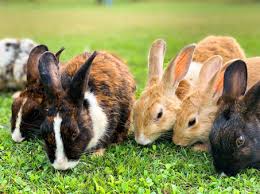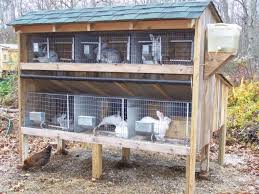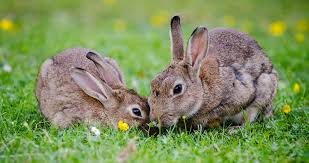Rabbit farming is an increasingly popular agricultural venture that offers numerous benefits, including high meat yield, fast reproduction rates, and low feed costs. As a small-scale livestock operation, rabbit farming requires less space compared to traditional livestock, making it ideal for urban and suburban settings.
Additionally, rabbits are environmentally friendly, as they produce less waste and require less water than larger livestock. These attributes have led to a growing interest in rabbit farming among entrepreneurs and hobbyists alike.
One of the key advantages of rabbit farming is its profitability. With rising demand for lean protein and sustainable food sources, rabbit meat is gaining recognition for its nutritional value and health benefits.
Rabbit meat is lower in fat and cholesterol compared to beef or pork, making it an attractive option for health-conscious consumers. Furthermore, the market for rabbit meat is expanding, providing farmers with ample opportunities to sell their products, whether directly to consumers, through farmers’ markets, or via local restaurants.
Proper management and understanding of effective rabbit farming techniques can significantly increase the chances of success in this endeavor.
To start a rabbit farming business, one must first understand the different breeds available and choose those that best fit their production goals. Breeds like New Zealand White, Californian, and Flemish Giant are popular for their meat quality and growth rates. Selecting the right breed will impact the overall productivity and profitability of the farm.
Additionally, it is crucial to consider the housing requirements of rabbits. Proper housing ensures the health and comfort of the animals, which directly influences their growth and reproduction.
Rabbits need secure and well-ventilated living spaces that protect them from predators and harsh weather conditions. Many farmers opt for hutches or cages designed to provide adequate space for movement and activity.
These should be cleaned regularly to prevent disease and maintain a hygienic environment. The arrangement of the housing system also plays a role; some farmers implement a colony system, allowing rabbits to socialize, which can lead to improved well-being and reduced stress.
Feeding is another vital aspect of rabbit farming. A balanced diet rich in fiber is essential for their growth and reproduction. High-quality hay, fresh vegetables, and specially formulated pellets should form the core of their diet.
Nutritional needs may vary depending on the age, breed, and purpose of the rabbits. Regular access to clean water is also crucial, as it supports their overall health and productivity.
In addition to conventional rabbit farming techniques, integrating sustainable practices can enhance the viability of the farm.
For instance, utilizing waste from rabbits as fertilizer for gardens or crops can reduce costs and promote a circular farming system. Furthermore, adopting organic farming methods can attract a niche market willing to pay a premium for sustainably raised rabbit meat.
Processing of Medicinal Plants should also be considered alongside rabbit farming, as it complements agricultural diversification. Farmers can explore the potential of cultivating medicinal plants while managing rabbits, maximizing the use of available land and resources. This approach not only boosts income but also promotes biodiversity and sustainability within the farming ecosystem.
Choosing the Right Rabbit Breeds

1. Purpose of Raising Rabbits: Before selecting a breed, determine your purpose for raising rabbits. Common purposes include meat production, fur production, show animals, or as pets. Each breed has specific characteristics suited to different needs.
2. Meat Rabbit Breeds: If your primary goal is meat production, consider breeds like New Zealand White or California rabbits. These breeds are known for their rapid growth rates and high meat yield. They typically have a good feed-to-meat conversion ratio, making them economical choices for meat production.
3. Fur Rabbit Breeds: For fur production, breeds like Rex or Angora are excellent options. Rex rabbits have a soft, velvety coat, while Angoras produce long, fluffy fur that is highly valued in the textile industry. Choose a breed based on the type of fur you wish to produce and the climate in your area.
4. Show Rabbit Breeds: If you are interested in participating in rabbit shows, consider breeds recognized by rabbit associations, such as Holland Lop or Mini Rex. These breeds have distinct appearances and personalities, making them popular among rabbit fanciers.
5. Pet Rabbit Breeds: For companionship, breeds like Netherland Dwarf or Lionhead are ideal. These smaller breeds are often friendly and easy to handle, making them suitable for families and individuals looking for a pet rabbit.
6. Mixed Breeds: Consider adopting mixed-breed rabbits, which can often have unique appearances and temperaments. Mixed breeds may also have fewer health issues due to a diverse gene pool. Check local shelters or rescues for available rabbits that fit your needs.
Setting Up the Rabbitry
1. Choosing a Location: Select a well-ventilated, dry area for your rabbitry. Ideally, this space should be away from direct sunlight, strong winds, and extreme weather conditions. Access to electricity and water is also beneficial for heating, cooling, and cleaning purposes.
2. Design and Layout: Plan your rabbitry layout for efficient management. Consider the number of rabbits you intend to raise, and design separate areas for breeding, growing, and adult rabbits. This separation helps manage their care and reduces stress.
3. Equipment Needs: Equip your rabbitry with essential supplies such as cages, feeding and watering systems, bedding materials, and nesting boxes. Cages should be spacious enough for the rabbits to move around comfortably and made of durable materials that are easy to clean.
4. Health and Hygiene: Ensure that your rabbitry is designed for easy cleaning and maintenance. Establish a routine for cleaning cages, removing waste, and disinfecting the area to minimize the risk of diseases. Proper sanitation helps maintain a healthy environment for your rabbits.
5. Temperature Control: Depending on your climate, you may need to implement heating or cooling systems to maintain a comfortable temperature for your rabbits. Rabbits are sensitive to extreme temperatures, so ensure they have access to shaded areas in hot weather and warmth during cold months.
6. Security Measures: Protect your rabbitry from predators and theft by installing secure fencing and locks. Ensure that cages are escape-proof and that the rabbitry is located in a safe area away from potential threats.
Read Also: How to Farm and Care for Daggertooth Pike Conger Fish (Muraenesox cinereus)
Housing Requirements for Rabbits

1. Cage Size and Space: Each rabbit should have enough space to stand up on its hind legs, stretch out, and move comfortably. A general guideline is a minimum of 4 square feet for smaller breeds and up to 8 square feet for larger breeds. Ensure that the cages are also tall enough for rabbits to stand fully upright.
2. Cage Materials: Use strong materials like wire mesh for the cage’s walls to prevent escape and protect against predators. The flooring should be solid to avoid injuries to the rabbit’s feet. Consider adding bedding made from straw, hay, or recycled paper for comfort and warmth.
3. Nesting Boxes: Provide nesting boxes for breeding rabbits, especially females preparing to give birth. These boxes should be dark and private, allowing the doe to feel secure while nesting. The box should be filled with clean straw or hay to provide a soft environment for the kits.
4. Group Housing: If raising multiple rabbits, consider group housing to allow social interactions. Ensure that the space is large enough to prevent fighting and stress. Monitor their behavior to ensure compatibility among rabbits.
5. Outdoor Housing Considerations: If housing rabbits outdoors, provide protection from extreme weather, direct sunlight, and predators. Create shaded areas, and ensure the cages are raised off the ground to prevent flooding during rain.
6. Indoor Housing Considerations: If keeping rabbits indoors, set aside a specific room or area for their enclosure. Ensure the space is rabbit-proofed by removing any harmful items or plants and providing safe toys for entertainment.
Feeding and Nutrition for Rabbits
1. Importance of Proper Nutrition: A balanced diet is crucial for the overall health and well-being of rabbits. Proper nutrition promotes healthy growth, reproduction, and prevents various health issues, including obesity and gastrointestinal problems.
2. Main Components of Rabbit Diet: Rabbits are herbivores and require a diet primarily composed of hay, fresh vegetables, and pellets. Hay, particularly timothy hay, is vital as it provides the necessary fiber to support digestive health and prevents dental problems.
3. Fresh Vegetables: In addition to hay, rabbits can be fed a variety of fresh vegetables such as leafy greens (romaine lettuce, kale, parsley), carrots, and bell peppers. Vegetables should be introduced gradually to prevent digestive upset. Aim to provide 1 to 2 cups of mixed vegetables daily for adult rabbits.
4. Rabbit Pellets: Commercial rabbit pellets should be high in fiber (at least 18%) and low in protein (around 14-16%). Pellets provide essential vitamins and minerals to complement hay and vegetables. Feed pellets according to the rabbit’s age and weight, typically around ¼ to ½ cup for adults, but limit the quantity to prevent obesity.
5. Fresh Water: Access to clean, fresh water is essential at all times. Dehydration can lead to severe health issues in rabbits. Provide water in a heavy bowl or a water bottle, ensuring it is filled regularly.
6. Treats and Snacks: Offer occasional treats such as small pieces of fruit (like apples or berries) or herbs (like basil or mint). Treats should be limited to avoid overfeeding and should not exceed 5% of the total diet.
Health Care and Common Diseases
1. Regular Health Checks: Regular health assessments are essential to monitor your rabbit’s condition. Check for signs of good health, such as bright eyes, clean fur, and normal eating and drinking habits.
2. Common Health Issues: Be aware of common health issues that rabbits face, such as dental problems, gastrointestinal stasis, respiratory infections, and parasites. Symptoms like lethargy, lack of appetite, or abnormal droppings may indicate a health issue that requires veterinary attention.
3. Vaccinations and Vet Care: Consult a veterinarian for routine check-ups and vaccinations. Vaccinations against diseases like myxomatosis and viral hemorrhagic disease (VHD) may be necessary, depending on your region.
4. Spaying and Neutering: Consider spaying or neutering pet rabbits to prevent unwanted litters and reduce certain health risks. This procedure can also help manage behavioral issues, such as aggression or territoriality.
5. Maintaining a Clean Environment: Keep the rabbit’s living area clean to prevent the spread of diseases. Regularly clean the cages, change bedding, and remove uneaten food and droppings.
6. Emergency Preparedness: Familiarize yourself with emergency care procedures for rabbits. Have contact information for a veterinarian and keep first aid supplies on hand, such as bandages and antiseptic ointments.
Read Also: Apple Maggot: Description, Damages Caused, Control and Preventive Measures
Breeding Techniques and Management

1. Selecting Breeding Stock: Choose healthy rabbits with desirable traits for breeding. Consider their lineage, temperament, and physical characteristics. Conduct genetic testing if possible to prevent hereditary diseases.
2. Breeding Timeline: A typical breeding cycle for rabbits is around 28-32 days. After successful mating, the doe (female rabbit) should be housed separately in a nesting box to prepare for kindling (giving birth) about 30 days after breeding.
3. Preparing for Kindling: Provide a clean, comfortable nesting box filled with hay or straw for the doe to nest. She may pull fur from her body to line the nest, so ensure the environment is quiet and stress-free.
4. Caring for Kits: After the doe gives birth, monitor her and the kits (baby rabbits) for any signs of distress. Kits are born hairless and blind, relying on their mother for warmth and nutrition. The doe will nurse them a few times a day. Avoid handling the kits until they are at least a few weeks old to minimize stress on the mother.
5. Weaning: Kits are usually weaned at about 6-8 weeks of age. Gradually introduce them to solid food during this period. After weaning, separate them based on gender to prevent unwanted breeding.
6. Record Keeping: Maintain detailed records of breeding dates, health checks, and growth patterns of the rabbits. This information is essential for managing breeding practices and ensuring the health of the herd.
Raising Rabbits for Meat vs. Pets
1. Purpose and Goals: Raising rabbits for meat involves breeding them for optimal growth rates and carcass yield, while raising them as pets focuses on companionship, temperament, and behavior. Understanding your goals will shape your approach to feeding, care, and housing.
2. Feeding and Nutrition Differences: Meat rabbits may be fed a higher protein diet to promote growth, whereas pet rabbits require a balanced diet that focuses more on fiber to maintain digestive health. Adjust the diet based on the specific needs of the rabbits.
3. Housing Considerations: Meat rabbits often require larger, more efficient housing setups to accommodate their numbers and promote optimal growth. In contrast, pet rabbits need more social interaction and mental stimulation, requiring setups that allow for play and exploration.
4. Handling and Socialization: Pet rabbits require regular handling and socialization to develop a friendly temperament. Spend time with them daily, providing gentle interactions. Meat rabbits may be handled less frequently, primarily for health checks and breeding purposes.
5. Breeding Practices: For meat production, select rabbits based on growth potential and meat quality. For pets, focus on selecting rabbits that exhibit calm and friendly behaviors to ensure they are suitable companions.
6. Emotional Attachment: While raising rabbits for meat may not encourage emotional attachment, raising them as pets fosters a bond between the owner and the rabbit. Consider your ability to form attachments when choosing your purpose for raising rabbits.
Sustainable Practices in Rabbit Farming
1. Sustainable Feeding Practices: Opt for locally sourced feeds to reduce transportation emissions and support local farmers. Consider growing your own rabbit forage, such as clover, alfalfa, or grasses, to ensure a fresh, sustainable food supply. Utilizing kitchen scraps (safe vegetable waste) can also minimize waste and reduce feeding costs.
2. Waste Management: Implement composting systems to manage rabbit waste. Rabbit manure is an excellent fertilizer due to its high nitrogen content and can be composted with bedding material to create nutrient-rich compost for gardens. This practice helps recycle nutrients and reduces reliance on chemical fertilizers.
3. Housing Design: Design rabbit housing with sustainability in mind. Use eco-friendly materials and ensure proper ventilation and insulation to minimize energy use. Natural light can reduce the need for artificial lighting, and proper airflow helps maintain a healthy environment for the rabbits.
4. Integrated Pest Management (IPM): Adopt IPM strategies to manage pests sustainably. Use biological controls, such as beneficial insects or natural repellents, to minimize chemical pesticide use. Regular monitoring and maintaining a clean environment can help prevent pest infestations.
5. Ethical Breeding Practices: Focus on breeding healthy rabbits to reduce the risk of hereditary diseases. Implement selective breeding practices that prioritize the well-being of the animals, ensuring they have the best chance for a healthy life.
6. Community Engagement: Connect with local farmers and organizations to share knowledge and resources. Participating in community-supported agriculture (CSA) or farmers’ markets can promote sustainable practices and increase awareness of rabbit farming.
Marketing Rabbit Products
1. Identify Your Target Market: Understand who your potential customers are. This could include local consumers, restaurants, or specialty food stores interested in fresh, sustainably raised rabbit meat. Tailoring your marketing strategy to meet the needs of your target audience can improve sales.
2. Highlight the Benefits of Rabbit Products: Emphasize the nutritional advantages of rabbit meat, which is lean, high in protein, and low in fat. Market rabbit as a sustainable and environmentally friendly alternative to traditional meats, appealing to health-conscious and environmentally aware consumers.
3. Use Social Media and Online Marketing: Establish a strong online presence through social media platforms and a dedicated website. Share educational content about rabbit farming, recipes, and the benefits of rabbit meat. Engaging with your audience through regular posts and promotions can build a loyal customer base.
4. Attend Local Markets and Events: Participate in farmers’ markets, food festivals, or local fairs to showcase your products. Offering samples or demonstrations can attract attention and encourage purchases. Connecting with your community can foster brand loyalty and awareness.
5. Develop Value-Added Products: Consider creating processed rabbit products, such as sausages, jerky, or pâtés. These value-added products can enhance profit margins and attract a broader customer base. Ensure compliance with local regulations when producing and selling processed foods.
6. Create a Brand Identity: Develop a unique brand identity that reflects your values and mission. This includes creating a logo, packaging design, and marketing materials that resonate with your target audience. A strong brand can differentiate you in a competitive market.
Financial Considerations in Rabbit Farming
1. Initial Investment: Assess the startup costs involved in rabbit farming, including purchasing rabbits, housing, equipment, feed, and veterinary care. Creating a detailed budget will help you understand the financial commitment and plan accordingly.
2. Operating Costs: Calculate ongoing expenses such as feed, bedding, healthcare, utilities, and marketing. Understanding these costs is crucial for maintaining profitability. Keep detailed records of all expenditures to identify areas for potential savings.
3. Pricing Strategy: Establish a pricing strategy that reflects your costs while remaining competitive in the market. Consider factors such as production costs, local market prices, and the perceived value of your products. Regularly review and adjust pricing as necessary.
4. Profit Margins: Determine the profit margins for each product you offer. Understand the difference between fixed costs (e.g., housing) and variable costs (e.g., feed) to gauge profitability. Aim for a sustainable profit margin that supports reinvestment into the farm.
5. Diversification: Consider diversifying your product offerings or farming practices to mitigate risks and increase revenue. For example, adding a line of organic pet food or exploring breeding for show rabbits can create additional income streams.
6. Funding and Grants: Explore funding options such as agricultural grants, loans, or local government assistance programs for sustainable farming initiatives. Researching available resources can help secure financial support for your operation.
Do you have any questions, suggestions, or contributions? If so, please feel free to use the comment box below to share your thoughts. We also encourage you to kindly share this information with others who might benefit from it. Since we can’t reach everyone at once, we truly appreciate your help in spreading the word. Thank you so much for your support and for sharing!
Read Also: Tips for Maintaining a Clean Garbage Disposal
Frequently Asked Questions
We will update this section soon.

